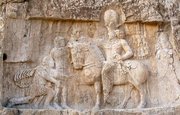Valerian (emperor)
|
|
Aureus_Valerian-RIC_0034.jpg
Publius Licinius Valerianus (Latin: IMPERATOR·CAESAR·PVBLIVS·LICINIVS·VALERIANVS·PIVS FELIX·INVICTVS·AVGVSTVS)¹ (ca. 200 - 260), known in English as Valerian, was Roman emperor from 253 to 260.
Unlike the majority of the usurpers of the crisis of the third century, Valerian was of a noble and traditional senatorial family. Details of his early life are elusive, but his marriage known to Egnatia Mariniana who gave him two sons: Publius Licinius Egnatius Gallienus and Valerianus Minor.
In 238 he was princeps senatus, and Gordian I negotiated through him for Senatorial acknowledgement for his claim as Emperor. In 251, when Decius revived the censorship with legislative and executive powers so extensive that it practically embraced the civil authority of the emperor, Valerian was chosen censor by the senate. Under Decius he was nominated governor of the Rhine provinces of Noricum and Raetia and retained the confidence of his successor, Trebonianus Gallus, who asked him for reinforcements to quell the rebellion of Aemilianus in 253. Valerian headed south, but was too late: Gallus' own troops killed him and joined Aemilianus before his arrival. The Raetian soldiers then proclaimed Valerian emperor and continued their march towards Rome. At the time of his arrival in September, Aemilianus' legions defected, killing him and proclaiming Valerian emperor. In Rome, the Senate quickly acknowledged him, not only for fear of reprisals, but also because he was one of their own.
Valerian's first act as emperor was to make his son Gallienus colleague. In the beginning of his reign the affairs in Europe went from bad to worse and the whole West fell into disorder. On the East, Antioch had fallen into the hands of a Persian vassal, Armenia was occupied by Shapur I (Sapor). Valerian and Gallienus split the problems of the empire between the two, with the son taking the West and the father heading East to face the Persian threat.
By 257, Valerian had already recovered Antioch and the Syria province to Roman control but in the following year, the Goths ravaged Asia Minor. Later in 259, he moved to Edessa, but an outbreak of plague killed a critical number of legionaries, weakening the Roman position. Valerian was then forced to seek terms with Shapur I. Sometime towards the end of 259, or at the beginning of 260, Valerian was defeated and made prisoner by the Persians (making him the only Roman Emperor taken captive). It is said that he was subjected to the greatest insults by his captors, such as being used as a human stepladder by Shapur when mounting his horse. After his execution, his skin was stuffed with straw and preserved as a trophy in the chief Persian temple. Despite several usurpation attempts, Gallienus secured the throne until his own assassination in 268.
Owing to imperfect and often contradictory sources, the chronology and details of this reign are very uncertain.
Valerian and Gallienus' joint rule was threatened several times by usurpers. See Gallienus usurpers for the full account.
Notes
IMPERATOR·CAESAR·PVBLIVS·LICINIVS·VALERIANVS·PIVS FELIX·INVICTVS AVGVSTVS In English, "Emperor Caesar Publius Licinus Valerianus; Pious and Lucky; Undefeated Augustus".
| Preceded by: Aemilianus | Roman Emperor 253–260 with Gallienus | Succeeded by: Gallienus Template:End boxcs:Valerianus de:Valerian I. et:Valerianus fr:Valérien it:Valeriano I nl:Valerianus I ja:ウァレリアヌス pl:Walerian fi:Valerianus sv:Valerianus |

